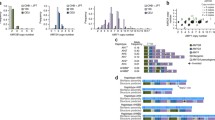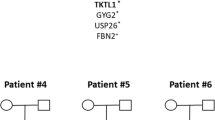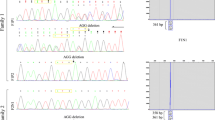Abstract
The authors test single nucleotide polymorphisms (SNPs) in coding sequences of 12 candidate genes involved in glucose metabolism and obesity for associations with spina bifida. Genotyping was performed on 507 children with spina bifida and their parents plus anonymous control DNAs from Hispanic and Caucasian individuals. The transmission disequilibrium test was performed to test for genetic associations between transmission of alleles and spina bifida in the offspring (P < .05). A statistically significant association between Lys481 of HK1 (G allele), Arg109Lys of LEPR (G allele), and Pro196 of GLUT1 (A allele) was found (P = .019, .039, and .040, respectively). Three SNPs on 3 genes involved with glucose metabolism and obesity may be associated with increased susceptibility to spina bifida.
Similar content being viewed by others
References
Nyberg DA, McGahan JP, Pretorius DH, Pilu G, eds. Neural tube defects and the spine. In: Diagnostic Imaging of Fetal Anomalies. Philadelphia, PA: Lippincott Williams and Wilkins; 2003:291–293.
Botto LD, Moore CA, Khoury MJ, Erickson JD Neural-tube defects. N Engl J Med. 1999;341(20):1509–1519.
Shaw GM, Quach T., Nelson V., et al. Neural tube defects associated with maternal periconceptional dietary intake of simple sugars and glycemic index. Am J Clin Nutr. 2003;78:972–978.
Groenen PM, Petronella GP, Wevers RA, et al. Maternal myoinositol, glucose, and zinc status is associated with the risk of offspring with spina bifida. Am J Obstet Gynecol. 2003;189: 1713–1719.
Shaw GM, Velie EM, Schaffer D. Risk of neural tube defect-affected pregnancies among obese women. JAMA. 1996;275: 1093–1096.
Hendrick KA, Nuno OM, Suarez L., Larson R. Effects of hyperinsulinemia and obesity on risk of neural tube defects among Mexican Americans. Epidemiology. 2001;12:630–635.
Chang TI, Loeken MR Genotoxicity and diabetic embryopathy: impaired expression of developmental control genes as a cause of defective morphogenesis. Semin Reprod Endocrinol. 1999;17(2):153–165.
Fine EL, Horal M., Chang TI, Fortin G., Loeken MR Evidence that elevated glucose causes altered gene expression, apoptosis, and neural tube defects in a mouse model of diabetic pregnancy. Diabetes. 1999;48:2454–2462.
Moley KH, Chi MM, Knudson CM, Korsmeyer SJ, Mueckler MM Hyperglycemia induces apoptosis in pre-implantation embryos through cell death effector pathways. Nat Med. 1998; 4(12):1421–1424.
Fu J., Tay SS, Ling EA, Dheen ST High glucose alters the expression of genes involved in proliferation and cell-fate specification of embryonic neural stem cells. Diabetologia. 2006;49:1027–1038.
Moley KH Hyperglycemia and apoptosis: mechanisms for congenital malformations and pregnancy loss in diabetic women. Trends Endocrinol Metab. 2001;12(2):78–82.
Phelan SA, Ito M., Loeken MR Neural tube defects in embryos of diabetic mice: role of the Pax-3 gene and apoptosis. Diabetes. 1997;46(7):1189–1197.
Hagay ZJ, Weiss Y., Zusman I., et al. Prevention of diabetes-associated embryopathy by overexpression of the free radical scavenger copper zinc superoxide dismutase in transgenic mouse embryos. Am J Obstet Gynecol. 1995;173(4):1036–1041.
Wood SI, Trayhurn P. Glucose transporters (GLUT and SGLT): expanded families of sugar transport proteins. Br J Nutr. 2003;89(1):3–9.
Brewster R., Altaba A. Hexokinase I is a Gli2-responsive gene expressed in the embryonic CNS. Mech Dev. 2000;99:159–162.
Sivitz WI, Walsh SA, Morgan DA, Thomas MJ, Haynes WG Effects of leptin on insulin sensitivity in normal rats. Endocrinology. 1997;138(8):3395–3401.
Emilsson V., Liu Y., Cawthorne M., Morton N., Davenport M. Expression of the functional leptin receptor mRNA in pancreatic islets and direct inhibitory action of leptin on insulin secretion. Diabetes. 1997;46(2):313–316.
Pani L., Horal M., Loeken MR Rescue of neural tube defects in Pax-3-deficient embryos by p53 loss of function: implications for Pax-3-dependent development and tumorigenesis. Genes Dev. 2002;16:676–680.
Weksler-Zangen S., Yaffe P., Ornoy A. Reduced SOD activity and increased neural tube defects in embryos of the sensitive but not of the resistant Cohen diabetic rats cultured under diabetic conditions. Birth Defects Res A Clin Mol Teratol. 2003;67:429–437.
Knapp M. The transmission/disequilibrium test and parental-genotype reconstruction: the reconstruction-combined transmission/disequilibrium test. Am J Hum Genet. 1999;64: 861–870.
Knapp M. Using exact p-values to compare the power between the reconstruction-combined transmission/disequilibrium test and the sib transmission/disequilibrium test. Am J Hum Genet. 1999;65:1208–1210.
Kawamura K., Sato N., Fukuda J., et al. Leptin promotes the development of mouse preimplantation embryos in vitro. Endocrinology. 2002;143:1922–1931.
Park KS, Shin HD, Park BL, et al. Polymorphisms in the leptin receptor (LEPR)-putative association with obesity and T2DM. J Hum Genet. 2006;51:85–91.
Lakka T., Rankinen T., Weisnagel S., et al. Leptin and leptin receptor gene polymorphisms and changes in glucose homeostasis in response to regular exercise in nondiabetic individuals: the HERITAGE family study. Diabetes. 2004;53(6):1603–1608.
Shaw GM, Barber R., Todoroff K., Lamer EJ, Finnell RH Microsatellites proximal to leptin and leptin receptor as risk factors for spina bifida. Teratology. 2000;61:231–235.
Morita Y., Tsutsumi O., Oka Y., Taketani Y. Glucose transporter GLUT1 mRNA expression in the ontogeny of glucose incorporation in mouse preimplantation embryos. Biochem Biophys Res Commun. 1994;199(3):1525–1531.
Trocino R., Akazawa S., Takino H., et al. Cellular-tissue localization and regulation of the GLUT-1 protein in both the embryo and the visceral yolk sac from normal and experimental diabetic rats during the early postimplantation period. Endocrinology. 1994;134:869–878.
Matsumoto K., Akazawa S., Ishibashi M., et al. Abundant expression of GLUT1 and GLUT3 in rat embryo during the early organogenesis period. Biochem Biophys Res Commun. 1995;209(1):95–102.
Chi M., Pingsterhaus J., Carayannopoulos M., Moley K. Decreased glucose transporter expression triggers BAX-dependent apoptosis in the murine blastocyst.JBiol Chem. 2000;275(51): 40252–40257.
Heilig CW, Saunders T., Brosius FC, et al. Gucose transporter-1-deficient mice exhibit impaired development and deformities that are similar to diabetic embryopathy. Proc Natl Acad Sci U S A. 2003;100(26):15613–15618.
Smith PJ, Zhang C., Wang J., Chew SL, Zhang MQ, Krainer AR An increased specificity score matrix for the prediction of SF2/ASF-specific exonic splicing enhancers. Hum Mol Genet. 2006;15(16):2490–2508.
Zhang X., Chasin L. Computational definition of sequence motifs governing constitutive exon splicing. Genes Dev. 2004;18:1241–1250.
Zhang X., Kangsamaksin T., Chao M., Banerjee J., Chasin L. Exon inclusion is dependent on predictable exonic splicing enhancers. Mol Cell Biol. 2005;25(16):7323–7332.
Fairbrother WG, Yeh RF, Sharp PA, Burge CB Predictive identification of exonic splicing enhancers in human genes. Science. 2002;297:1007–1013.
Wang Z., Rolish M., Yeo G., Tung V., Mawson M., Burge C. Systematic identification and analysis of exonic splicing silencers. Cell. 2004;119:831–845.
D’Souza I., Poorkaj P., Hong M., et al. Missense and silent tau gene mutations cause frontotemporal dementia with parkinsonism-chromosome 17 type, by affecting multiple alternative RNA splicing regulatory elements. Proc Natl Acad Sci U S A. 1999; 96:5598–5603.
Chao HK, Hsiao KJ, Su TS A silent mutation induces exon skipping in the phenylalanine hydroxylase gene in phenylketonuria. Hum Genet. 2001;108:14–19.
Montera M., Piaggio F., Marchese C., et al. A silent mutation in exon 14 of the APC gene is associated with exon skipping in a FAP family. J Med Genet. 2001;38(12):863–867.
Waller K., Shaw GM, Rasmussen SA, et al. Prepregnancy obesity as a risk factor for structural birth defects. Arch Pediatr Adolesc Med. 2007;161:745–750.
Rathmell JC, Fox CJ, Plas DR, Hammerman PS, Cinalli RM, Thompson CB Akt-directed glucose metabolism can prevent Bax conformation change and promote growth factor-independent survival. Mol Cell Biol. 2003;23(20):7315–7328.
Majewski N., Nogueira V., Bhaskar P., et al. Hexokinase-mitochondria interaction mediated by Akt is required to inhibit apoptosis in the presence or absence of Bax and Bak. Mol Cell. 2004;16(5):819–830.
Gottlob K., Majewski N., Kennedy S., Kandel E., Robey RB, Hay N. Inhibition of early apoptotic events by Akt/PKB is dependent on the first committed step of glycolysis and mitochondrial hexokinase. Genes Dev. 2001;15(11):1406–1418.
Vander Heiden MG, Plas DR, Rathmell JC, Fox CJ, Harris MH, Thompson CB Growth factors can influence cell growth and survival through effects on glucose metabolism. Mol Cell Biol. 2001;21(17):5899–5912.
Fine EL, Horal M., Chang TI, Fortin G., Loeken MR Evidence that elevated glucose causes altered gene expression, apoptosis, and neural tube defects in a mouse model of diabetic pregnancy. Diabetes. 1999;48(12):2454–2462.
Chi H., Sarkisian MR, Rakic P., Flavell RA Loss of mitogenactivated protein kinase kinase kinase 4 (MEKK4) results in enhanced apoptosis and defective neural tube development. Proc Natl Acad Sci U S A. 2005;102(10):3846–3851.
Author information
Authors and Affiliations
Corresponding author
Additional information
This work was supported by grants from the National Institutes of health (P01 HD35946) and the Shriners Hospital for Children (project 8580).We are grateful to Drs James Hixson and Lawrence Shimmin for technical support with the SNPlex experiments, to Phong X.Tran and Chester Tsai for technical support and data management, and to Michelle R. Dewhurst for helpful discussions. We thank the patients and their families for participation in this study.
Rights and permissions
About this article
Cite this article
Davidson, C.M., Northrup, H., King, T.M. et al. Genes in Glucose Metabolism and Association With Spina Bifida. Reprod. Sci. 15, 51–58 (2008). https://doi.org/10.1177/1933719107309590
Published:
Issue Date:
DOI: https://doi.org/10.1177/1933719107309590




